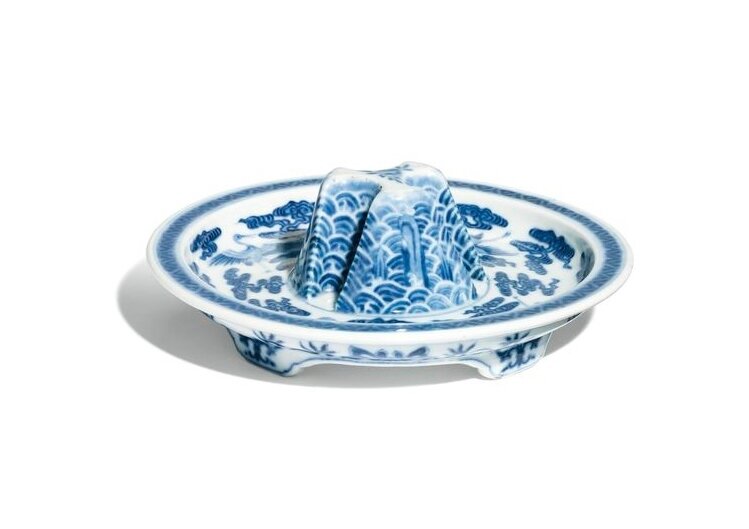the shallow rounded sides rising from four short cloud-shaped feet to an everted rim and surmounted by a mountain-shaped support to the centre, painted with rocks and turbulent waves, encircled by cranes in flight amidst ruyi clouds and a chevron band at the rim, the exterior with lotus sprays, inscribed to the base in underglaze blue with a four-character seal mark; 16.5 cm, 6 1/2 in.
Note: A Qianlong mark and period stand of this form and with its matching jue, in the Victoria and Albert Museum, London, is illustrated in Rose Kerr, Chinese Ceramics, London, 1986, pl. 44; two were sold in these rooms, the first, 20th April 1971, lot 46, and the second, 2nd/3rd December 1974, lot 466; and a pair was sold at Christie’s New York, 21st November 1991, lot 405. See also two stands of this type sold in our Hong Kong rooms, one, 21st May 1980, lot 161, and the other, 24th May 1984, lot 377.
Used as supports for drinking vessels in the form of archaic bronze jue, stands of this rare shape are modelled after Ming dynasty prototypes, such as a blue and white jue and stand, in the National Palace Museum, Taipei, included in the Museum’s exhibition Catalogue of a Special Exhibition of Dragon-Motif Porcelain in the National Palace Museum, Taipei, 1983, cat. no. 56.
Sotheby's. Important Chinese Art Londres, 11 mai 2016, 10:00 AM

/https%3A%2F%2Fprofilepics.canalblog.com%2Fprofilepics%2F1%2F0%2F100183.jpg)
/https%3A%2F%2Fstorage.canalblog.com%2F03%2F02%2F119589%2F96711876_o.jpg)
/https%3A%2F%2Fstorage.canalblog.com%2F11%2F31%2F119589%2F94773502_o.jpg)
/https%3A%2F%2Fstorage.canalblog.com%2F20%2F83%2F119589%2F94772815_o.jpg)
/https%3A%2F%2Fstorage.canalblog.com%2F26%2F72%2F119589%2F75604929_o.jpg)
/https%3A%2F%2Fstorage.canalblog.com%2F59%2F60%2F119589%2F26458628_o.jpg)




/image%2F1371349%2F20240416%2Fob_2a8420_437713933-1652609748842371-16764302136.jpg)
/image%2F1371349%2F20240414%2Fob_83ee65_2024-nyr-22642-0954-000-a-blue-and-whi.jpg)
/image%2F1371349%2F20240414%2Fob_15808c_2024-nyr-22642-0953-000-a-blue-and-whi.jpg)
/image%2F1371349%2F20240414%2Fob_e54295_2024-nyr-22642-0952-000-a-rare-blue-an.jpg)